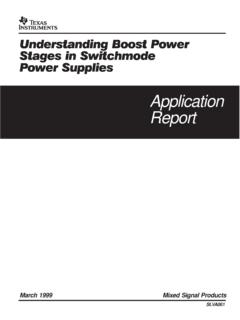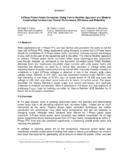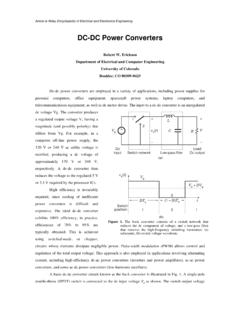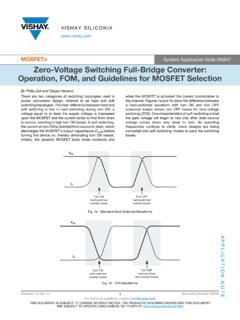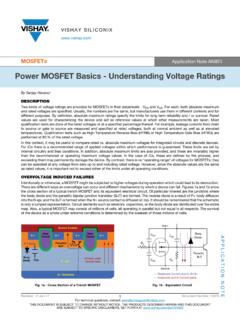Transcription of Rotations, Specialization, Positions, Switching and Stacking
1 Rotations, Specialization, Endline Sideline Positions, Switching and Stacking Introduction In this section, we will cover some of the basic principles that are useful for new 10 ft. line players to understand how to position (aka 3 m. line ). themselves at the beginning of rallies during a volleyball match. Net To start, take a quick look at the court shown on the right. That will give you a frame of reference for a lot of the diagrams that follow. 10 ft. line (aka 3 m. line ). Sideline Endline Service Rotation Most people who have played any volleyball have been introduced to the idea of service rotation.
2 There are six positions on the court (3 front row and 3 back row) and one of the positions is the designated server. Players rotate through each of these positions, serving when they rotate to the designated position. Here you can see the court split into 6 equal parts - 3 front row players and 3 back row players. Position 1 is the server's position. When you rotate to that spot, it's your turn to serve. (Note: you can actually serve from anywhere behind the endline. You don't have to serve from that region of the court). 4 3 2. Players rotate clockwise through each of these positions. Another way to remember it is the player in 1 serves first, the player in 2 serves next, the player in 3 serves third, and so on.
3 The order of rotation is set at the beginning of the game and maintained throughout the game (excepting substitutions). You rotate after you win a point off of the opposing team's serve. 5 6 1. You can use this system to describe where you are in the service rotation. For instance, if you started the game as the server, you would be starting in position 1. The next time your team wins the serve, you rotate and you would now be in position 6 of the service rotation. You might not PLAY in this position during a point (as you'll see later). You might not even STAND in this physical location during the serve (as you'll also see later), but this is your position in the service rotation.
4 Player Positions, Part I. The numbering system used to describe where you are in the service rotation can also be used to describe where you are playing on the court during the play and not just during the serve. So if you play the front row, middle position, you would play the 3 . So if a person 4 3 2 described herself as a 4 , you could tell where she usually plays by matching it up to the position on the court. This method is less common for describing player positions, but is very commonly used to reference areas of the court (see below). 5 6 1. LF MF RF. Another way to describe a player's position focuses on the actual physical position where the player is playing (left front, middle front, right front, left back, middle back, left back).
5 Note the orientation assumes you are facing LB MB RB. the net. These descriptions are most commonly used when you want to target a region of the opponent's court. Reminder! These systems assume a frame of reference where you are facing the net. So as you face the net, position 1 on your side is right back. If you want to serve to the opponent's position 1 , you have to serve the area your opponents would consider right back (as they face the net). Player Positions, Part II. So you can describe where a player is in the service rotation using the numbering system described. You can use the same numbering system to describe where the player plays during the point or you can use a physical description of the player's location to describe where the player plays during the point.
6 Yet another way of describing where a player plays during the point is to describe the player's primary responsibilities. The name is by no means a complete job description! Setter This player distributes the ball to various hitters, trying to set up high quality attacks. There is usually one setter on the court although some systems use two setters. We look for many different qualities in potential setters. Many people focus on a player's hands . when thinking about good setters. That is, how pretty does the set look? Does it come out of the player's hands with no spin? While this is a factor, we look for at least three other characteristics in a setter.
7 Does the player have good set placement (the ability to put the ball in the right place at the right height at the right tempo)? Does the player have enough speed or anticipation to get to many balls that are passed imperfectly? Finally, does the player have the ability to lead the team and get them to give her a little extra effort on the court? Outside hitter (also called left side). This player is usually responsible for a majority of the hitting from the outside (left front) position. Often, this player is also one of the primary passers in serve receive. There are usually two outside hitters on the court.
8 Leaping ability and power are two commonly considered characteristics for the outside hitter, but the outside hitter actually needs to have a balanced set of skills. She needs to be able to pass really well. She needs to be able to play quality defense. She needs to be able to score (as opposed to just hit hard). Middle blocker (sometimes called middle hitter). This position is primarily responsible for blocking the opposing team's middle hitter and helping to block against the opposing team's left and hitters. At more advanced levels of play, the middle is also expected to provide a source of high percentage offense.
9 There are usually two middle blockers. Height is always useful for a middle blocker, but she also needs to have a reasonable jump and good timing. She needs speed to cover the net from sideline to sideline, agility in order to maneuver around the court efficiently and a good sense of spatial relations so she can locate the ball and teammates while on the move. Player Positions, Part II (continued). Opposite (also called right side). The opposite usually starts opposite the setter in the service rotation (hence the name). This position has different expectations based on the level of play, but typically, the opposite hits from right front, serves as the primary blocker against the opposing team's outside hitter, serves as one of the primary passers and acts as the backup setter if the setter makes the first defensive contact on the ball.
10 There is usually one opposite on the court (if there aren't two setters). At beginning levels, the opposite is usually someone who has one particularly good quality that you want to get onto the court. For instance, she might be a really good blocker or the next best setter. Another common candidate for the beginning opposite is someone who has the smarts and attitude to handle playing on the right side (which is often more difficult and disorienting for the novice, right-handed player). A final useful consideration is whether the hitter is left-handed or not; left-handed hitters usually have an easier time hitting from the right side of the court.
